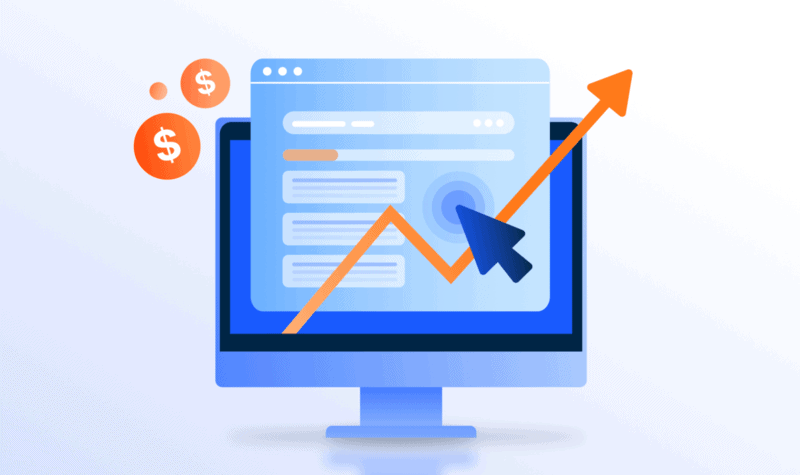Why A/B Testing Is Essential For Improving Your Ppc Campaign’s Performance.

A/B testing has emerged as a valuable tool for enhancing the performance of PPC campaigns. This method involves testing two or more versions of an element within a campaign, such as ad copy, landing page design, or call-to-action strategies, to determine which version yields better results.
The objective and impersonal nature of A/B testing allows for systematic evaluation and comparison of different variables, enabling advertisers to make data-driven decisions that enhance campaign performance. By identifying the most effective elements, advertisers can optimize their campaigns and achieve higher click-through rates, conversions, and overall return on investment (ROI).
This article will explore the benefits of A/B testing in improving PPC campaign performance, provide guidance on setting up effective experiments, and discuss strategies for analyzing and interpreting test results. Furthermore, it will examine specific elements that can be tested, such as ad copy, landing page design, and targeting options, emphasizing the importance of continuous testing for ongoing campaign improvement.
Key Takeaways
- A/B testing is crucial for improving the performance of PPC campaigns.
- Targeting options play a significant role in enhancing audience engagement and campaign performance.
- Marketers can create multiple versions of ads or landing pages and randomly assign them to different segments of the target audience for A/B testing.
- Continuous optimization through iterative changes based on insights from A/B testing leads to better results in PPC campaigns.
Understanding A/B Testing and Its Benefits
A/B testing is a valuable method for evaluating the effectiveness of different elements in a PPC campaign, allowing advertisers to make data-driven decisions that can improve overall performance.
The benefits of A/B testing for PPC campaigns are numerous. Firstly, it enables advertisers to identify the most effective ad copy, landing pages, and calls to action by testing different variations. This helps in optimizing the campaign for better click-through rates and conversion rates.
Additionally, A/B testing allows advertisers to understand their target audience better, as it provides insights into what resonates with them. Moreover, it helps in identifying any underperforming elements in the campaign and provides opportunities for improvement.
To conduct successful A/B tests in PPC advertising, best practices recommend testing one element at a time, using a large enough sample size, and running the test for a sufficient duration to ensure reliable results.
Setting Up Effective A/B Testing Experiments
To optimize the outcomes of PPC campaigns, it is crucial to establish well-designed experiments that enable effective comparisons between different versions of the campaign.
One aspect of A/B testing involves testing ad placement. By experimenting with different ad placements, such as above the fold or within the content, advertisers can determine which placement generates the highest click-through rates and conversions.
Additionally, A/B testing allows advertisers to experiment with different ad formats. This involves testing variations in the ad design, headline, copy, and call-to-action to identify the most effective combination.
Through these experiments, advertisers can gather empirical data on the performance of different ad formats, enabling them to make data-driven decisions and optimize their PPC campaigns.
Ultimately, effective A/B testing experiments can significantly improve the performance and ROI of PPC campaigns.
Analyzing and Interpreting A/B Test Results
Analyzing and interpreting the results of A/B tests provides advertisers with valuable insights into the effectiveness of different ad formats and placements, allowing them to make data-driven decisions to optimize their PPC campaigns. By interpreting data obtained from A/B tests, advertisers can measure the success of their campaigns and identify areas for improvement. This process involves examining key metrics such as click-through rates, conversion rates, and return on investment.
Through careful analysis, advertisers can determine which variation of the ad or landing page performed better and draw conclusions about the impact of specific changes on user behavior. This helps advertisers understand what elements of their PPC campaigns are working well and what changes need to be made to maximize performance.
Ultimately, interpreting A/B test results enables advertisers to make informed decisions based on empirical evidence, leading to more effective and successful PPC campaigns.
- Sub-list 1:
- Improved campaign performance
- Increased return on investment
- Sub-list 2:
- Data-driven decision making
- Optimizing ad formats and placements
Optimizing Ad Copy for Better Performance
Optimizing ad copy can significantly enhance the effectiveness of PPC campaigns by attracting and engaging target audiences with persuasive and compelling messaging. Ad targeting and keyword optimization play crucial roles in this process. Ad targeting ensures that the ad reaches the right audience, increasing the chances of a click-through and conversion. Keyword optimization involves selecting relevant keywords that align with the target audience’s search queries, leading to improved ad visibility. By utilizing these strategies, advertisers can create ads that resonate with their audience, increasing the likelihood of clicks and conversions. To illustrate the importance of optimizing ad copy, consider the following table:
| Ad Copy Variation | Click-Through Rate (CTR) | Conversion Rate |
|---|---|---|
| Variation A | 2.5% | 8% |
| Variation B | 3.2% | 9.5% |
| Variation C | 2.1% | 7.5% |
| Variation D | 2.7% | 8.3% |
| Variation E | 3.5% | 10% |
From the table, it is evident that Variation E has the highest click-through rate and conversion rate, indicating its effectiveness in engaging the target audience. This highlights the importance of optimizing ad copy to improve the performance of PPC campaigns.
Enhancing Landing Page Design for Higher Conversions
Enhancing the design of landing pages is a pivotal factor in increasing conversion rates and maximizing the effectiveness of PPC campaigns. A well-designed landing page can significantly improve user experience, leading to higher engagement and conversion rates.
A crucial aspect of enhancing landing page design is testing color schemes. Colors can evoke different emotions and impact users’ perception of a brand or product. A/B testing different color combinations allows marketers to identify which color scheme resonates best with their target audience and leads to higher conversions.
By analyzing the data and insights obtained from A/B testing, marketers can make informed decisions on the most effective color schemes to implement on their landing pages. This iterative process of testing and optimizing the design of landing pages ensures continuous improvement in PPC campaign performance.
Testing Different Call-to-Action Strategies
Testing different call-to-action strategies is an integral component of refining landing page design for increased conversions and improved user engagement.
A call-to-action (CTA) serves as a prompt for users to take a specific action, such as making a purchase or signing up for a newsletter.
By testing various CTAs, marketers can determine which strategy is most effective in driving conversions. A/B testing allows for a comparison between different CTAs, measuring their effectiveness based on key metrics such as click-through rates and conversion rates.
This data-driven approach enables marketers to make informed decisions about which call-to-action strategies to implement, ultimately improving conversion rates and maximizing the return on investment (ROI) of PPC campaigns.
By continuously testing and optimizing CTAs, marketers can ensure that their landing pages are designed to effectively guide users towards desired actions.
Exploring Targeting Options for Improved Audience Engagement
Exploring various targeting options enables marketers to strategically engage their target audience, fostering meaningful connections and enhancing the effectiveness of their PPC campaigns. By implementing different targeting strategies and audience segmentation techniques, marketers can optimize their campaigns to reach the right people at the right time.
Here are three key targeting options that can improve audience engagement:
- Demographic Targeting: By considering factors such as age, gender, location, and income, marketers can tailor their ads to specific demographic groups, ensuring that their message resonates with the intended audience.
- Interest-based Targeting: By analyzing users’ online behavior and interests, marketers can target individuals who have shown a genuine interest in the products or services they offer. This approach allows for more personalized and relevant ad experiences.
- Remarketing: By targeting users who have previously interacted with their website or shown interest in their offerings, marketers can increase brand recall and conversion rates. Remarketing campaigns can be highly effective in re-engaging potential customers and driving them towards a desired action.
Implementing these targeting options can significantly enhance audience engagement, leading to improved campaign performance and higher return on investment.
Leveraging A/B Testing for Continuous Campaign Improvement
Leveraging A/B testing allows marketers to continuously improve their campaigns by objectively analyzing different variables and optimizing their strategies for maximum effectiveness. A/B testing involves creating two or more versions of an ad or landing page and randomly assigning them to different segments of the target audience. By measuring the performance of each version, marketers can identify which variables have the greatest impact on campaign success. Continuous optimization is achieved by making iterative changes based on the insights gained from A/B testing. Performance measurement is essential in this process, as it enables marketers to quantify the impact of their optimization efforts and make data-driven decisions. The table below illustrates an example of A/B testing for a PPC campaign, comparing two versions of an ad with different headlines and analyzing their click-through rates.
| Ad Version | Headline | Click-through Rate |
|---|---|---|
| Version A | “Get 50% Off Today!” | 2.5% |
| Version B | “Limited Time Offer!” | 3.2% |
By systematically testing different variables, marketers can continuously refine their campaigns and drive better results.
Frequently Asked Questions
How long should an A/B testing experiment run in order to gather statistically significant results?
To effectively analyze A/B testing data and determine the optimal sample size, it is important to run the experiment for a sufficient duration that allows for statistically significant results to be gathered.
Are there any specific metrics or key performance indicators (KPIs) that should be tracked and measured during A/B testing?
During A/B testing, specific metrics and key performance indicators (KPIs) should be tracked and measured to evaluate the effectiveness of different variations. These metrics provide objective insights into user behavior and help optimize PPC campaign performance.
What are some common mistakes to avoid when setting up A/B testing experiments?
Common pitfalls in setting up A/B testing experiments include not properly defining objectives, using small sample sizes, and ignoring statistical significance. Adequate sample size is crucial to obtain reliable and meaningful results in A/B testing.
How can A/B testing be used to improve the overall user experience on a website or landing page?
A/B testing can be used to improve the overall user experience on a website or landing page by optimizing the user interface and improving conversion rates. It allows for data-driven decision-making and helps identify design elements that resonate better with users.
What are some best practices for implementing A/B testing in PPC campaigns while minimizing any potential negative impact on ad performance?
Some best practices for implementing A/B testing in PPC campaigns while minimizing negative impact on ad performance include testing variations of ad copy, landing pages, and targeting, and using statistical significance to make data-driven decisions for optimizing campaigns.






